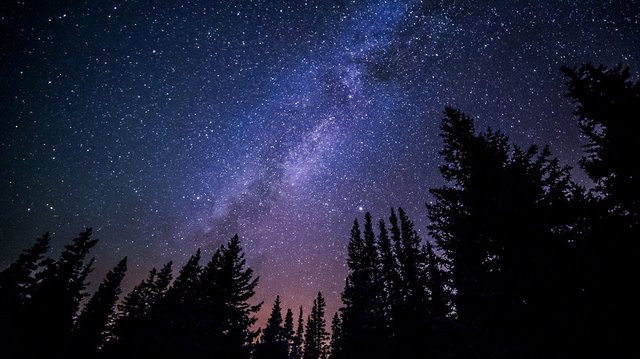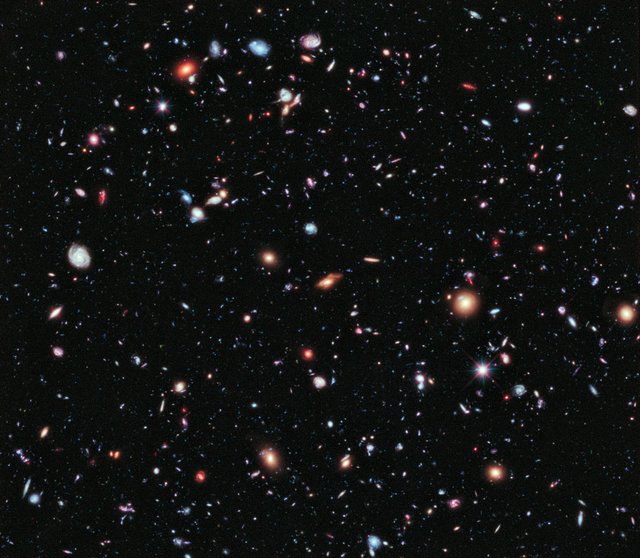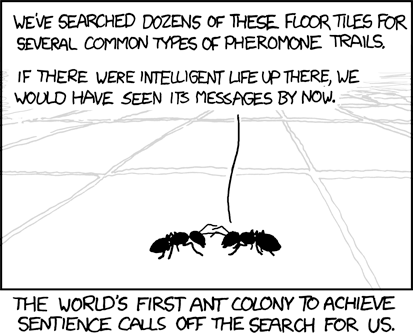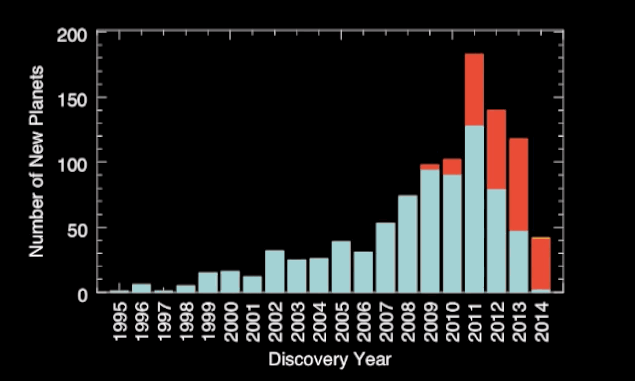Five Ways The Cosmos Fills Me With Awe
 (Milky Way)
(Milky Way)Pondering the cosmos never fails to make me feel minuscule and insignificant, but it still reliably overwhelms me with awe and wonder. Below I’ve collected together a short list of a few of the ways that this universe of ours blows my mind, and makes me infinitely grateful to be alive to appreciate it.
1. An Interactive Map of the Milky Way
If you feel the need to have your life put into perspective, then this is the tool for you. Astronomers at Edinburgh and Cambridge universities have processed thousands of images captured by telescopes operating in Hawaii and Chile, to produce an interactive map of the milky way’s galactic plane that allows you to zoom in to incredible levels of detail. The full image consists of a staggering 150 billion pixels, and includes approximately 1 billion stars. You could quite easily lose hours scrolling around the galaxy, exploring aimlessly. What amazes me in particular about this is just how densely packed with stars each tiny point is — it’s one thing to read the word “one billion”, but it really packs a punch when you see it visually. I haven’t included an image here because it almost feels like I’d be posting a spoiler! And as if you needed your mind blowing even further, this image only displays a tiny proportion (about 1%!) of the stars in the milky way — with the general consensus estimating a total of 100–400 billion.
2. Take a Ride Aboard the International Space Station
If your sights are set a little closer to home then hop aboard the International Space Station’s 24/7 live stream — the High Definition Earth Viewing (HDEV) experiment. It’s a beautiful and relaxing view — which is surprising considering its being beamed down from 4 HD cameras strapped to the bottom of the ISS, tearing around Earth at 17,100 mph and exposed to the harsh radiation of space. Its mission is to test the effects of these conditions on video quality over time, but whilst its operational the live stream is a very happy side effect! If the stream is black, then this is because the ISS is currently on the night side of the Earth, but a full orbit only takes 93 minutes so check back again soon. Also, check out the video above that shows a timelapse of images showing how it feels to fly over Earth at night. This includes all sorts of happenings that you might not be able to catch yourself on the live stream, such as lightening storms, the Earth’s ionosphere, a satellite and a sunrise.
3. The Hubble Deep Field Series

Hubble
The most recent updates from the Hubble telescope Deep Field images have been both breathtaking and humbling. The photo in the header above is The Hubble Extreme Deep Field (XDF), one of the most recent installments in a series of increasingly hyperbolically named images delivered to us by Hubble. Click here to enlarge and view in its full glory! The Extreme Deep Field is a compilation of over 2000 images over a 10 year period (with a combined exposure time of 23 days), looking at a tiny area of space in the middle of the field previously looked at by the Ultra Deep Field. Click here to view a video showing how these observations were assembled and overlaid to form the final image.

Hubble XDF View
To give you a sense of scale, see in the image above the size of the XDF's view compared to the size of the moon as seen from Earth. Ridiculously small. This makes it all the more mind-boggling to consider that with the exception of a few stars, every tiny bit of light in the above image is an entire galaxy, each of which contains billions of stars. For me, taking into account both the sheer number of stars and the mounting hints toward liquid water and possibly habitable conditions within our own Solar System (Mars, Enceladus, Europa, Titan), it's difficult to contemplate there not being some form of intelligent life within this small rectangle alone, let alone within the entire universe.
The Universe itself is 13.7 billion years old - some of the galaxies in this image are up to 13.2 billion years old, making these images the furthest back in time we have ever seen. The XDF shows examples of galaxies in all stages of development: early galaxy formation, established spiral galaxies like our own, and full on galaxy collisions. Using red-shift calculations, the video below shows a 3D journey outwards from the Hubble telescope, allowing you to fly through the galaxies back in time to near the beginning of the Universe. Or if you have an IMAX cinema nearby, I can't recommend Hubble 3D enough!
Hubble may only hold this record for a little while longer, as the upcoming James Webb Space Telescope (armed with its incredible Infrared vision) will also be aimed at the XDF region and is expected to find even younger galaxies from when the universe was only a few hundred million years old. However, this won’t be until at least 2018 and with ongoing projects like the Frontier Fields program, Hubble isn’t going to be defeated just yet. Using updated cameras on Hubble and using a technique called “gravitational lensing” (using the warp of spacetime around nearby clusters of galaxies as a natural lens), we have been able to see things 10 or 20 times fainter than anything we’ve seen before. Due to the gravitational warping of the light, very distant galaxies that are behind these lenses from our perspective appear magnified and brighter.
4. The Drake Equation - Are We Alone in the Universe?

XKCD
The Drake Equation is a probabilistic calculation that has been used to estimate the number of extraterrestrial civilizations who might be out there in our galaxy, attempting to communicate with one another. Although it was not designed to exactly fulfill this purpose, it is still an interesting thought experiment that summarises the key elements we must factor in when estimating who else might be out there. Although a lot of the values we need to input into the equation are mostly educated guesses, even when our estimates are very conservative, the results suggest it is very unlikely that we are alone in the universe.
As with most things cosmological, The Drake Equation is best explained by Carl Sagan. This is an old classic and probably something that many of you will have seen before, but it never fails to make me smile — I could listen to Carl talk all day about broccoli and I’d still find it fascinating. The figures in this video are now out of date, but a separate post on the updated Drake Equation is in the pipeline.
5. Kepler’s Quest for Exoplanets

NASA
Following on naturally from the above is Kepler, a space observatory launched by NASA in 2009 on a mission to discover Earth-like planets outside of our solar system — also known as exoplanets. In particular, Kepler is interested in planets that orbit with the habitable zone of their parent star — the zone in which a planet can support liquid water at their surface, and therefore potentially life. Although Kepler experienced some technical problems, the scientific community came to the rescue, modifying the existing mission plans to search for habitable planets around smaller, dimmer red dwarf stars. There’s something about the Kepler mission that really highlights what an exciting time it is to be alive. Within our lifetimes, as a civilisation we have gone from only knowing about the handful of planets in our solar system, to a total of 3550 planets as I publish this article and in all likelihood a higher number by the time you’re reading it.
If you feel inspired and want to help out with discovering more exoplanets by analysing observations from Kepler, head over to Planet Hunters. There’s a great tutorial, so it’s quite easy to become a citizen scientist!
Thanks for reading
Thanks for reading my first Steemit post! I will continue to publish similar content in the upcoming weeks, so be sure to follow if you'd like more posts about philosophy, cosmology and consciousness. Also let me know if you prefer these longer form posts, or whether you'd prefer shorter ones.
This post was previously published (by me) on Medium, and any future content I create will be posted on both platforms. If you want to follow me elsewhere you can find me at:
Twitter - @ongoingwow
Medium - @ongoingwow
Instagram - @ongoingwow
Nice post! Keep the good work up!
Thanks :) That means a lot!
#life
Dr. Seuss:You have brains in your head. You have feet in your shoes. You can steer yourself any direction you choose.You're on your own. And you know what you know. And YOU are the one who'll decide where to go. :)
Haha :D Thanks Kaleem, but it's the Universe that's da real MVP.
👍👍👍👍
Congratulations @ongoingwow! You have completed some achievement on Steemit and have been rewarded with new badge(s) :
Click on any badge to view your own Board of Honor on SteemitBoard.
For more information about SteemitBoard, click here
If you no longer want to receive notifications, reply to this comment with the word
STOP